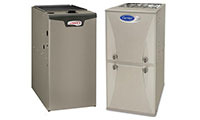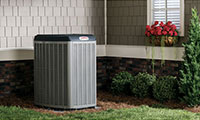Single-stage, two-stage, modulating furnaces, and what it all means to you
When looking to replace your old furnace for a brand new one, nowadays you are faced with a multitude of choices that can be overwhelming. All the big brand furnace manufacturers offer a range of single-stage, two-stage and modulating (or variable) furnaces with varying efficiency ratings and so on but the most important thing to consider is that most manufacturers offer comparable models with similar features, regardless of whether they are single-, two-stage or modulating furnaces.

Oversimplification of the differences between the three types of furnaces.
The above graph is an oversimplification of the main concept of the difference between the three kinds of furnaces and it is usually what most people hear when talking to an expert or salesman. It is not wrong but it is not the full picture either. The graph shows a marked difference in temperature swings between single- and two-stage furnaces but as with most things, it is relative.
Single-stage furnaces
This is the most basic and widespread type of furnace you can buy and it is the type of furnace that most people are familiar with. They are called single-stage because they work like a simple on/off switch. When the temperature goes below the desired temperature on the thermostat, the furnace turns itself on full blast until the temperature goes above the desired point and then the cycle repeats itself. This is what generates the temperature swings.
Two-stage furnaces
If a single-stage furnace is like an simple on/off switch, one can think of a two-stage furnace as working in the same way as those small desk-top fans that only have three speeds: 0, 1, and 2. Two-stage furnaces can be either off, on low capacity or full blast. Other than that, they work in much the same way as a single-stage furnace but with a lower temperature swing (in theory) because it does not let the temperature go down as low as a single-stage would before it starts the low capacity stage.
A note on the energy efficiency of staged furnaces
A lot of people like to say that two-stage furnaces are more energy efficient than single-stage ones. This is simply not true. To know which particular furnace is more or less efficient, one has to refer to their AFUE rating. The higher the AFUE, the more efficient a furnace is. Plain and simple.

Modulating furnaces have the ability to control the heat output.
Modulating furnaces
To continue the household items analogies, if single-stage furnaces are an on/off switch, and two-stage furnaces are like 3-speed fans; modulating furnaces control the heat that comes out of the vents in your home the same way that a tap controls the amount of water that comes out of a faucet. This effectively reduces the dreaded temperature swings and ensures that the temperature never goes up or down from the desired setting by more than one degree or so.
Truthfully, the jury is still out on whether modulating furnaces are any more efficient or quiet than any of the other two types of furnaces but the fact that it does a better job at keeping a steady temperature undoubtedly makes it the best of the three.


















